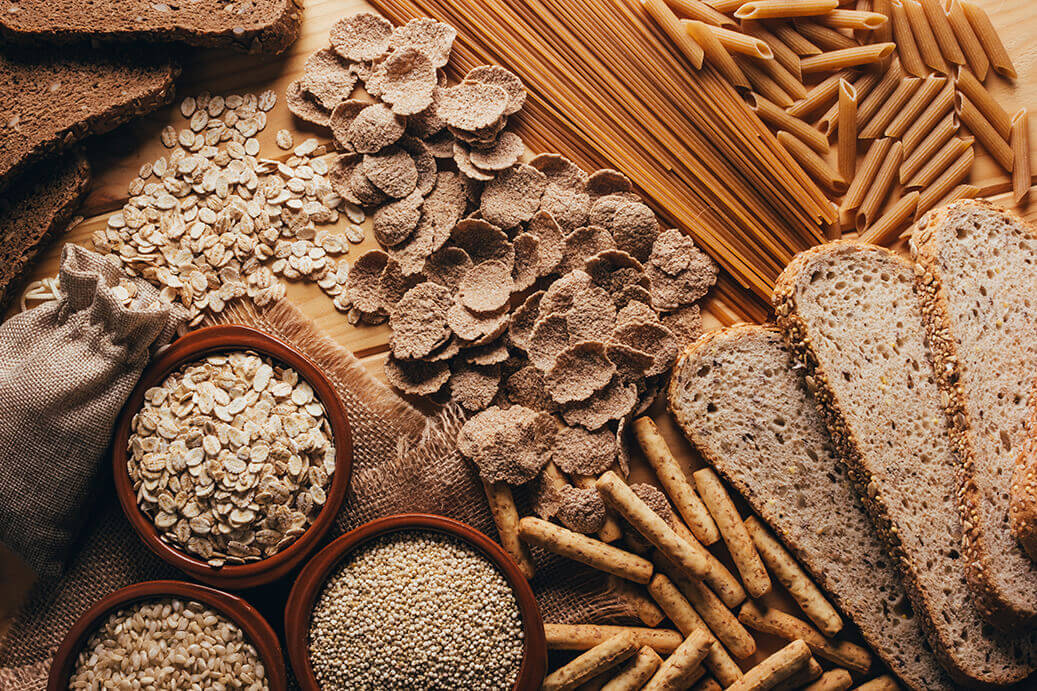Could carb cycling be the key to achieving your fitness goals? This method tailors your carbohydrate intake to when your body needs it most, fostering fat loss and muscle gain. Within this guide, we will unveil how to gear your carb intake to effectively fuel workouts and optimize recovery, detail a step-by-step approach to personalizing your carb cycling plan, and provide practical tips to maximize results without falling victim to common mistakes.
Key Takeaways
- Carb cycling is a diet strategy that involves alternating between high and low carbohydrate intake days in correspondence with one’s activity level and fitness goals, allowing for personal customization and optimization of weight loss and muscle gain.
- Successful carb cycling requires careful planning of macronutrient distribution, with a focus on complex, high-fiber carbohydrates on high-carb days and a more protein and fat-centric approach on low-carb days, including strategic adjustments for overcoming weight loss plateaus.
- The scientific principles of carb cycling aid in fat loss through the regulation of insulin sensitivity and metabolism, while strategic meal planning and pairing with appropriate workouts can enhance overall fitness outcomes and facilitate long-term maintenance.
Decoding Carb Cycling: A Strategic Approach to Dieting

Carb cycling is a unique dietary strategy that manipulates carbohydrate intake to match the body’s needs. It entails alternating between high and low-carb days to reach specific health and fitness goals. This includes promoting weight loss, increasing metabolic rate, and even facilitating muscle mass gain, making it a safe and healthy way to both lose weight and gain muscle mass.
Given its adaptable nature, carb cycling serves as a beneficial tool for those keen on enhancing their body composition and overall wellbeing. It doesn’t follow a one-size-fits-all approach but allows for personal customization according to individual needs and goals. Thus, it stands out from the crowd of other diets, offering a more tailored and effective weight loss strategy.
The Mechanics of a Carb Cycling Regimen
The magic of a carb cycling diet resides in its regimen. A typical carb cycling schedule includes a varying ratio of high to low carb days, often aligning higher carb intake days with training days and lower with rest days. This tailored approach allows the body to maximize the use of dietary carbs, replenish muscle glycogen on high-carb days, and encourage fat burning on low-carb days, especially on rest or lighter activity days.
Carb cycling goes beyond merely alternating carbs on a daily basis. Some individuals may opt for occasional high carb refeeds in a predominantly low carb dietary framework to accommodate fluctuations in activity level, muscle mass, and individual carbohydrate tolerance. In other words, it’s all about strategic carb consumption based on your body’s needs and your fitness goals.
Calculating Your Carb Intake: A Tailored Strategy
Grasping and customizing your carb intake forms the cornerstone of an effective carb cycling regime. It involves determining your daily carb intake based on your body weight, fitness goals, and physical demands and adjusting it accordingly. Let’s delve into the specifics of personalizing your carb cycle, monitoring carb quality, and making adjustments for plateaus.
Personalizing Your Carb Cycle
The allocation of macronutrients plays a pivotal role when you’re tailoring your carb cycle. On high-carb days, carbohydrates should make up about 50% of your calorie intake, which means you’ll consume more grams of carbs compared to other days. On the other hand, on low-carb days, carbohydrates should represent no less than 10-15% of calorie intake. This means that on high-carb days, your calorie intake would typically be distributed as 50% from carbohydrates, 40% from protein, and 10% from fat. In contrast, a low-carb day would see a distribution of 40% protein, 50% fat, and 10% carbohydrates.
Keep in mind, though, that these distributions are not inflexible and should be customized to address individual requirements and objectives. Consulting with a dietitian can ensure the right balance of nutrients and calories, enabling a more effective and personalized carb cycling approach.
Monitoring Carb Quality
Although the quantity is significant, the quality of carbs deserves equal attention. On high carb days, choosing complex carbohydrates high in fiber is advisable as they require the body to expend more energy for digestion. Some examples of complex carbohydrates high in fiber include:
- Oatmeal
- Brown rice
- Quinoa
- Sweet potatoes
These foods provide a sustained energy supply, helping you get through your high-carb days while maintaining a healthy diet.
Avoiding foods made from white grains and simple sugars is equally important. These refined carbohydrates can trigger a craving cycle that can be detrimental to your carb cycling plan. Thus, opting for quality carbs can make a world of difference in your carb cycling journey.
Adjustments for Plateaus
As with any diet, you might face plateaus in your carb cycling weight loss journey. However, strategic adjustments can help you overcome these standstills. This includes more extreme fluctuations in carb intake while adjusting dietary fat to compensate, or scheduled refeeds to jump-start your metabolism.
Another effective strategy is consuming several consecutive days of high carbs or having a cheat day to break through a weight loss plateau. However, while these strategies can be effective, it’s important to maintain a healthy diet and not exceed zero carb intake for more than three days. Dealing with plateaus can be challenging, but with the right adjustments, you can continue your progress towards your health goals.
Crafting a Carb Cycling Meal Plan

Formulating a bespoke carb cycling meal plan forms an integral part of the process. It involves designating specific high and low-carb days and incorporating versatile, nutrient-dense meals.
Let’s dive deeper into crafting meals for high and low-carb days.
High Carb Day Meals
Healthy carbohydrates take center stage on high-carb days. Consider incorporating the following foods into your diet:
- Sweet potatoes
- Oatmeal
- Whole wheat bread
- Brown rice
- Fruits
- Quinoa
To maximize the benefits of high carb days and improve insulin sensitivity, meals should be planned strategically around workouts, and increased calories should primarily come from carbohydrates.
For instance, a typical high-carb day meal could start with Gingerbread Buttermilk Pancakes for breakfast, move on to a Veggie & Hummus Sandwich for lunch, and end with Pesto Ravioli with Spinach & Tomatoes for dinner. High-fiber carbohydrates can help manage cravings, prevent blood sugar spikes, and maintain consistent energy levels.
Low Carb Day Strategies
Low-carb days on a low carb diet ought to concentrate on lean proteins, low-carb vegetables, and salubrious fats. Foods like poultry, fish, legumes, soy, spinach, kale, broccoli, cauliflower, avocados, nuts, seeds, and olive oil should be staples in your diet.
A balanced low carb day meal plan may feature evenly spaced meals such as a spinach and feta omelette for breakfast, grilled chicken salad for lunch, and salmon with vegetables for dinner. Snacks like celery sticks with almond butter can help manage hunger and energy. In essence, the key to low-carb days is to maintain energy and satiety while keeping carb intake low.
The Science Behind Fat Loss with Carb Cycling
Far from being another diet trend, carb cycling is based on scientific principles that aid in fat loss. One of these principles is the moderation of insulin release. By cycling carbohydrate intake, carb cycling allows more fat to be utilized for energy, which can improve insulin sensitivity.
Carb cycling also leverages the thermic effect of food during high-carb days. Periods of increased carbs lead to temporary boosts in leptin levels, aiding metabolism and fat burning. Furthermore, by regulating blood glucose levels, carb cycling helps balance cravings and lead to a reduction in overall caloric intake.
These scientific principles combine to make carb cycling a potent tool for fat loss, helping to burn fat and optimize energy use.
Potential Pitfalls and How to Avoid Them
Although carb cycling is a potent strategy, it’s not devoid of potential pitfalls. Determining the right amount of carbohydrates to consume on low, moderate, and high carb days can be challenging and time-consuming. Moreover, initiating a carb cycling meal plan may come with side effects such as cravings, changes in energy levels, and adjusting fluid levels, and long-term health risks can include trouble sleeping, constipation, kidney damage, electrolyte imbalance, and nutrient deficiencies.
To avoid these pitfalls, here are some tips to support a sustainable carb cycling plan:
- Gradually reduce junk food intake and manage cravings for high-carb foods.
- Adjust caloric intake by adding 200 calories to both high and low-carb days to improve strength for workouts without impeding fat loss goals.
- Abstain from overconsuming carbohydrates on high-carb days to ensure the efficacy of carb cycling.
Maintaining a balanced diet and monitoring nutrient intake can help you navigate potential pitfalls and enjoy the benefits of carb cycling.
Fitness Synergy: Pairing Workouts with Carb Cycling

Carb cycling and workouts synergize perfectly, forming a fitness powerhouse. Endurance athletes, for instance, can increase carbohydrate intake on intense training or race days, and decrease it on rest or low-intensity workdays. Similarly, strength athletes can consume more carbs on heavy training days for muscle glycogen replenishment and growth, and less on rest days to promote fat loss.
When working out in the gym or cycling outdoors, be sure to use a phone charging case so you can keep your phone fully charged so you track your progress without the worry about your phone battery dying.
High carb days are best suited for muscle-building exercises such as heavy weight lifting, while low carb days should focus on fat-burning activities like cardio or HIIT workouts. This targeted energy utilization and recovery approach contributes to enhanced athletic performance. Also, incorporating rest days, typically on low carb days, allows muscles time to repair and rebuild, which is critical for sustaining progress in muscle growth and overall performance within a carb cycling framework.
Indeed, pairing workouts with carb cycling can optimize your fitness outcomes.
Real-Life Success Stories: Transformations Through Carb Cycling
The efficacy of carb cycling extends beyond theory – it’s demonstrated in real-life scenarios. Consider the case of a certified strength and conditioning specialist who modified her carb intake through carb cycling, leading to fat loss and muscle building. Or the woman who shifted from a vegan diet to carb cycling, contributing to a significant weight loss of 135 pounds.
Beyond weight loss and reduced body fat, individuals experienced increased confidence and a healthier feeling as a result of the dietary changes. Transitioning to a low-carb intake and monitoring fat intake on some days initially posed challenges such as increased hunger, managed through the use of food tracking apps. By following this approach, they were able to lose fat effectively.
These success stories reveal the transformative potential of carb cycling, inspiring us to embark on our own carb cycling journey.
Comparing Carb Cycling to Other Diets
Carb cycling holds its own when juxtaposed with other diets. Unlike standard low-fat diets, carb cycling incorporates high-carb days, replenishing muscle glycogen and providing energy for intense workouts. It is often preferred by athletes and bodybuilders for muscle mass increase or fat loss.
Carb cycling is more demanding in terms of planning compared to the less structured intermittent low carb diets, which are easier to follow for the general population not pursuing high-level fitness goals. However, unlike a ketogenic diet, carb cycling allows for days with higher carb intake which prevents the body from staying in a constant state of ketosis. This flexibility, adaptability, and efficiency set carb cycling apart, making it a favorable diet strategy for many.
Navigating Social Situations and Eating Out
Adopting carb cycling does not necessitate abandoning socializing or dining out. In fact, with a bit of planning, you can enjoy these occasions while staying on track with your carb cycling plan. Planning meals in advance is crucial to adhere to your carb cycling plan when eating out.
Advance meal planning ensures that you can select appropriate high or low carb options that fit into your carb cycling schedule, helping avoid the temptation of unhealthy foods. By planning meals when dining out, you can enjoy social events without compromising your dietary progress.
So, with a little foresight and planning, you can balance your social life and diet goals.
Long-Term Maintenance: Transitioning from Carb Cycling
Achieving your initial goals with carb cycling doesn’t signify the end of the journey. Transitioning from carb cycling to long-term maintenance involves embracing a balanced diet that includes complex carbohydrates, lean proteins, and healthy fats. A gradual increase in daily carbohydrate intake can help the body adjust to a post-carb cycling eating pattern, ensuring a smooth transition.
Continued attention to portion sizes and caloric intake is crucial to avoid weight regain when moving away from a strict carb cycling regimen. Maintaining lifestyle habits such as staying hydrated, ensuring adequate sleep, and managing stress is vital for sustainable long-term weight maintenance.
Hence, moving away from carb cycling doesn’t signify a conclusion, rather it marks a fresh start towards a balanced, healthy lifestyle.
Summary
In conclusion, carb cycling is a powerful, flexible, and scientific approach to weight loss and muscle gain. It tailors carbohydrate intake to your body’s needs, aligns it with your workout routines, and offers a personalized diet plan to reach your health and fitness goals. Despite potential pitfalls, with careful planning and monitoring, carb cycling can deliver transformative results. So, are you ready to embark on your carb cycling journey and unlock your health and fitness potential?
Frequently Asked Questions
Is carb cycling good for weight loss?
Yes, carb cycling can be effective for weight loss as it helps to regulate insulin levels and promote fat loss.
How long does it take to see results from carb cycling?
You can expect to start feeling the effects of carb cycling in about a week, and start seeing noticeable results within two weeks.
What foods should you avoid when carb cycling?
When carb cycling, it's best to avoid highly processed foods that are low in fiber, such as white bread, sugary cereal, cakes, and cookies. Opt for whole foods like sweet potatoes, oatmeal, whole wheat bread, brown rice, fruit, and quinoa instead.
What is carb cycling?
Carb cycling is a dietary strategy that involves alternating between high and low-carb days to match the body's needs and reach specific health and fitness goals. It uses different types and amounts of carbohydrates to achieve desired results.
How does carb cycling enhance fat loss?
Carb cycling enhances fat loss by moderating insulin release, leveraging the thermic effect of food, and regulating blood glucose levels, leading to improved body composition and weight management.




Leave a comment
This site is protected by hCaptcha and the hCaptcha Privacy Policy and Terms of Service apply.